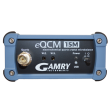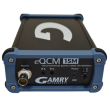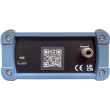Gamry’s eQCM 15M™ is an electrochemical quartz crystal microbalance (EQCM) compatible with any Gamry Reference or Interface Potentiostat. The EQCM adds a valuable tool in the analytical toolbox of anyone investigating interfacial processes. Corrosion, ion intercalation, ion adsorption, polymer growth, and sensor binding events are all interfacial processes that produce mass changes. These mass changes can be measured by monitoring the resonant frequencies of an oscillating quartz crystal.
Quartz Crystal Microbalance
eQCM 15M
I recently used the Gamry eQCM 15M to study the early stages of biofilm growth, and it has been an excellent addition to my research toolkit. The device is very user-friendly and integrates seamlessly with Gamry's Potentiostat, making data acquisition very easy. Additionally, the device automatically compensates for parasitic capacitance, eliminating the need for manual adjustments and ensuring accurate measurements. The accompanying software is particularly impressive; it is intuitive and provides a wide range of features for data collection and analysis, greatly simplifying the interpretation of results. What stands out most is the excellent after-sales support from Gamry. Whenever I had questions or needed assistance with the software or hardware, their team was always responsive and helpful. Overall, I highly recommend the eQCM 15M for anyone investigating interfacial processes
Organization: University of Greifswald
Application Area: Bioelectrochemistry
"Highly recommended"
Product Details
The eQCM 15M is a versatile electrochemical quartz crystal microbalance (EQCM) that accommodates any crystal from 1-15 MHz in any cell or holder. Its resolution allows you to detect mass changes on the ng/cm2 scale. This is less than a monolayer of material! Our system comes with everything you need to get started – the eQCM 15M, 5 MHz Au-coated crystals (5x), static cell, cables, manuals, and software.
eQCM 15M Features
- Any crystal from 1-15 MHz in any cell
- Detect ng/cm2
- USB Interface
- Integrated QCM and Gamry Potentiostat acquisition
- Impedance scanning gives both ƒs and ƒp, the series and parallel resonant frequencies
- Data Analysis in Gamry’s flexible and customizable Echem Analyst 2™
eQCM Applications
- Electroactive Polymers
- Li+ Intercalation
- Corrosion Studies
- Electrodeposition
- Self-Assembled Monolayers
- Antibody-Antigen Interactions
- Surfactant Adsorption
- Protein Adsorption
- Ion and Solvent Transport
The eQCM 15M rapidly scans a frequency window around the two resonant frequencies (these resonant frequencies are explained in our Basics of an eQCM Quartz Crystal Microbalance App Note). The advantage of scanning through the two resonant frequencies is that you no longer need to cancel the parasitic capacitance in order to maintain oscillation. Additionally, the relative impedance spectrum is displayed each time a data point is acquired, giving you insight into bubble formation on your electrode or improper cell setup. Having the two resonant frequencies also allows you to qualitatively see dissipation changes. When ƒs and ƒp respond similarly your film is rigid, however, when ƒs and ƒp respond differently the film is not rigid.
Resonator also allows you to adjust the driving amplitude of the crystal. This is especially important when working in an ionic liquid (IL) or a viscous solution where damping is especially high. The ability to manually increase the driving amplitude for heavily-loaded crystals offers a significant advantage over straight dissipation or time-resolved techniques.
Data analysis is done in our flexible and customizable Echem Analyst 2™. We give you a variety of plotting options to allow you to display the data as you want. You can plot straight mass change versus time, mass versus charge, mass versus potential, or a basic form of dissipation versus time.
Cleaning Crystals
A note about cleaning Quartz Crystal Microbalance crystals. We typically think of crystals as one-time use items but if you need to clean them, Pirhanna solution (the acidic one) can work well but take all of the necessary precautions when dealing with this solution. It is very dangerous and you should consult an MSDS and have proper safety training before using.
Specifications
FREQUENCY MEASUREMENT |
|
| Range | 1– 15 MHz |
| Resolution | 0.02 Hz |
ENVIRONMENTAL |
|
| Operating Temperature Range | 0 to 45°C |
| Relative Humidity | Maximum 90 (non-condensing)% |
| Storage and Shipping Temperature | -25 to 75°C |
| Maximum Shipping Acceleration | 30G |
GENERAL |
|
| Power | 3.5 W |
| Dimensions | 175x 115x 80 mm |
| Weight | 1 kg |
System Requirements
- USB 2.0 or USB C
- Microsoft® Windows™ 10/11
Manuals/Brochures
Reviews
I recently used the Gamry eQCM 15M to study the early stages of biofilm growth, and it has been an excellent addition to my research toolkit. The device is very user-friendly and integrates seamlessly with Gamry's Potentiostat, making data acquisition very easy. Additionally, the device automatically compensates for parasitic capacitance, eliminating the need for manual adjustments and ensuring accurate measurements. The accompanying software is particularly impressive; it is intuitive and provides a wide range of features for data collection and analysis, greatly simplifying the interpretation of results. What stands out most is the excellent after-sales support from Gamry. Whenever I had questions or needed assistance with the software or hardware, their team was always responsive and helpful. Overall, I highly recommend the eQCM 15M for anyone investigating interfacial processes
Organization: University of Greifswald
Application Area: Bioelectrochemistry
"Highly recommended"







